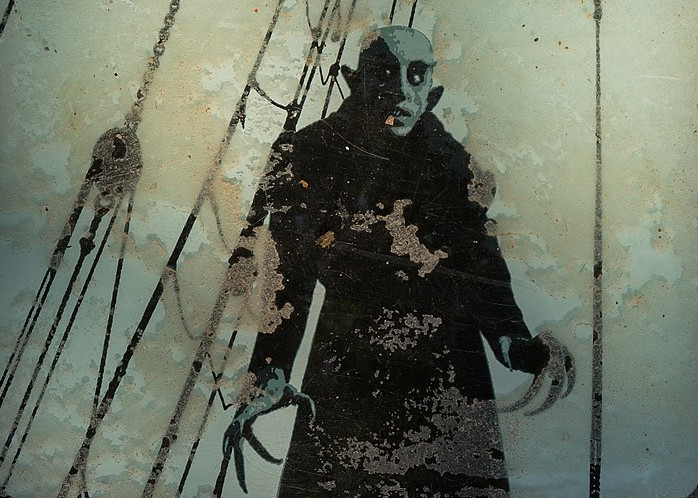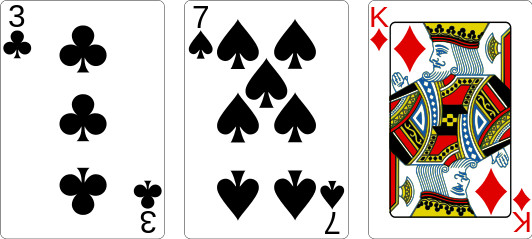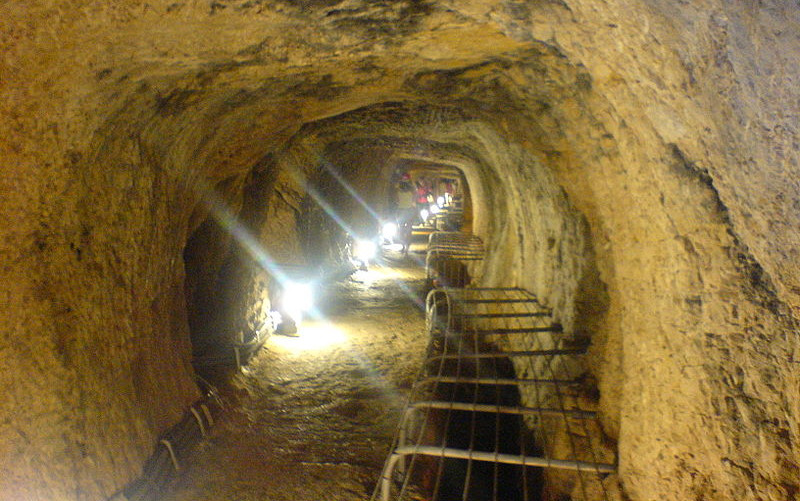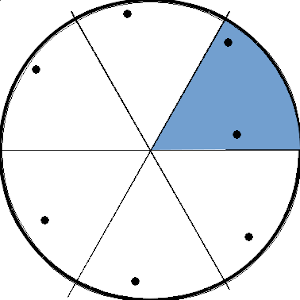Prove that if seven darts land on a dartboard, there will always be two darts that are no farther apart than the distance of one radius.
The Impossible Dream
In 2014, Italian artist Sven Sachsalber set out literally to find a needle in a haystack.
The performance, undertaken at the Palais de Tokyo in Paris, was allotted two days. Amazingly, Sachsalber found the needle with a few hours to spare.
Now we need a new saying.
Results
When the coal mines of Vulcan, W.Va., gave out in the early 1960s, the only legal route by which to enter and exit the town was a swinging bridge too narrow to accommodate a vehicle. The 200 remaining residents pleaded with the state to repair the bridge, but no action was taken, and in 1975 the bridge collapsed, leaving the residents hemmed in between a river to the west and impassable mountains to the east, reduced to using a hazardous gravel road owned by the Norfolk and Western Railway. Still state officials were reluctant to rebuild the bridge, noting the limited traffic it would carry and the competing priorities in the state.
So the residents of Vulcan wrote to the Soviet embassy in Washington, requesting foreign aid. Soviet journalist Iona Andronov arrived on Dec. 17, 1977, to survey the problem. “He was sincere,” said resident John Robinette. “The Russians said they would keep an eye on the bridge and see if it were built. If not, they would.”
Within an hour the state announced it would do the work, and today a one-lane bridge connects Vulcan to the outside world. “Our government was afraid the Russians would build the bridge,” Robinette said. “They were embarrassed into it, and nothing will convince me otherwise.”
(Thanks, Paul.)
Never Mind

“I do not remember this day.” — Dorothy Wordsworth, diary, March 17, 1798
“Such a beautiful day, that one felt quite confused how to make the most of it, and accordingly frittered it away.” — Caroline Fox, diary, January 4, 1848
“I shall not remember what happened on this day. It is a blank. At the end of my life I may want it, may long to have it. There was a new moon: that I remember. But who came or what I did — all is lost. It’s just a day missed, a day crossing the line.” — Katherine Mansfield, diary, Jan. 28, 1920
“Wrote nothing.” — Franz Kafka, diary, June 1, 1912
“I awakened feeling dull. The weather is neither cheerful nor depressing. It makes me restless. The trees are tossed by gusty, fantastic wind. The sun is hidden. If I put on my dressing-gown I am too hot, if I take it off I am cold. Leaden day in which I shall accomplish nothing worth while. Tired and apathetic brain! I have been drinking tea in the hope that it would carry this mood to a climax and so put an end to it.” — George Sand, diary, June 1, 1837
Samuel Johnson resolved 14 times “to keep a journal.” The first resolution was in 1760, the last in 1782.
A Sleeping Cat
Here’s a surprise: A new geoglyph has been found in the soil of the Nazca Desert in southern Peru.
This one, evidently a cat, appears to be the oldest yet — it may have been engraved in the earth as early as 200 B.C. and has been waiting all this time to be discovered.
“The figure was barely visible and was about to disappear because it is situated on quite a steep slope that’s prone to the effects of natural erosion,” the culture ministry wrote.
“It’s quite striking that we’re still finding new figures,” said chief archaeologist Johny Isla, “but we also know that there are more to be found.”
In a Word

acronical
adj. occurring at or just after sunset
Podcast Episode 316: A Malaysian Mystery

In 1967, Jim Thompson left his silk business in Thailand for a Malaysian holiday with three friends. On the last day, he disappeared from the cottage in which they were staying. In this week’s episode of the Futility Closet podcast we’ll review the many theories behind Thompson’s disappearance, which has never been explained.
We’ll also borrow John Barrymore’s corpse and puzzle over a teddy bear’s significance.
Resource Management

Back in 2009 I worried that, if vampires are constantly converting humans, eventually we must all succumb.
Apparently this fear is not unfounded. In 2006 physicists Costas Efthimiou and Sohang Gandhi worked out that if the first vampires had turned up in 1600, if they’d needed to feed only once a month, and if the world population at that time had been 536,870,911 (as estimated), then the vampire population would have increased geometrically and the last human would have succumbed in June 1602, after a bloodbath of only two and half years.
Worse, in 1982 a team of Austrian mathematicians led by R. Haiti and A. Mehlmann found that intelligent vampires could calculate a bloodsucking frequency that would maximize total utility per vampire and keep the human race alive indefinitely — and solutions exist no matter whether they’re “asymptotically satiated vampires,” “blood-maximizing vampires,” or “unsatiable vampires.”
Later they expanded on this to show that cyclical bloodsucking patterns are optimal. That’s not very comforting.
(Dino Sejdinovic, “Mathematics of the Human-Vampire Conflict,” Math Horizons 16:2 [November 2008], 14-15.)
The Third Card

Shuffle a deck and deal three cards face down. A friend looks at the cards and turns up two that are the same color. What’s the probability that the remaining card is also of this color?
The answer is not 1/2 but 1/4. Three randomly selected cards might have any of eight equally possible arrangements of color. In only two of these (RRR and BBB) are all the colors the same. So the chance of this happening is 2/8 = 1/4.
(Martin Gardner, “Modeling Mathematics With Playing Cards,” College Mathematics Journal 31:3 [May 2000], 173-177.)
10/18/2020 UPDATE: A number of readers have pointed out that the probabilities here aren’t quite accurate. Gardner was trying to show how various mathematical problems can be illustrated using a deck of cards and contrived this example within that constraint, focusing on the “seeming paradox” of 1/4 versus 1/2. But because the cards are dealt from a finite deck without replacement, if the first card is red then the second card is more likely to be black, and so on. So the final answer here is actually slightly less than 1/4 — which, if anything, is even more surprising, I suppose! Thanks to everyone who wrote in about this.
The Tunnel of Eupalinos

When the Greek engineer Eupalinos contrived a tunnel in the 6th century B.C. to carry water through Mount Kastro to Samos, he started digging simultaneously from the north and south, hoping that the two tunnels would meet in the heart of the mountain. He arranged this through some timely doglegs: When the two teams could hear one another (meaning they were about 12 meters apart), each deviated from its course in both the horizontal (left) and vertical (right) planes:

This ensured that they wouldn’t tunnel on hopelessly past one another on parallel courses.
This worked amazingly well: In fact the vertical alignment, established using levels at the start, had been maintained so faithfully that the two tunnels differed by only a few millimeters, though they’d traversed a combined distance of more than a thousand meters.
This is only the second known tunnel to be excavated successfully simultaneously from both ends, and the first to accomplish this feat using geometric principles, which Euclid would codify only centuries later.

